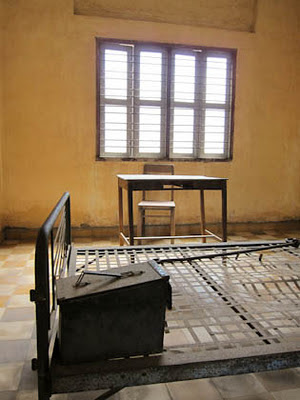Melissa Enderle's travelblog on her travels to Mali, Tunisia, Serbia, Eastern Europe, India, South Korea, China, and other places around the world.
Tuesday, January 31, 2012
Banteay Kdei, Cambodia
Sunday, January 29, 2012
Prasat Kravan, Cambodia
Saturday, January 28, 2012
Flaming Coconuts and Riverside Exercising
Thursday, January 26, 2012
The Killing Fields
Tuesday, January 24, 2012
S21: From School to Prison
While in Phnom Penh, we visited a very sobering site known as S21. Just years after it was built as a school (Tuol Svay Prey High School), the Khmer Rouge transformed the site into a prison where "Enemies of the Revolution" were detained, tortured, and killed. Aside from the barbed-wire meshed fence covering some entrances and balcony openings on the second floor, it still retained the resemblance of a school. Upon entering a classroom, however, things looked much different. In place of desks and chairs, several rooms contained a single bed, a box for bodily functions, and iron devices used to secure the hands and feet to the bed. Some also contained a chair and desk, from where a member of the Khmer Rouge would meticulously document about the current prisoner, including the torture process.
In another room, large panels displayed the photos of some of the 12,000 -20,000 individuals that went through the prison. Amongst the stark black&white photos were the faces of children. Hanging on the walls of some rooms were large photos of the decomposing bodies of tortured prisoners still shackled the bed when the prison was liberated, with pools of dried blood staining the floor beneath. Corners of the rooms also bore signs of torture, as did the blood spatters on the ceiling. Going up a very normal school stairway, we walked though rooms subdivided into crude cells the width of a toilet stall and other rooms subdivided with bricks.
According to our guide, the barbed wire covering the balcony openings was to prevent prisoners from jumping to kill themselves. In another room I read some of the excerpts written by the seven survivors, including an art teacher who believed he was answering the request for an art professor position. Of the two alive today, one was on-site, selling his book. One can only imagine the horrors he experienced within these walls.
Monday, January 23, 2012
National Museum, Phnom Penh
Sunday, January 22, 2012
Royal Palace, Phnom Penh
Saturday, January 21, 2012
Off to Cambodia
Tuesday, January 17, 2012
Siem Reap, Cambodia
Siem Reap, a set on Flickr.
After touring some sites in Phenom Penh, we flew to Siem Reap, Cambodia. Although most of our time was spent visiting the many sites within Angkor Wat, we did manage to see a traditional dance show, do a cooking class, and tour a place that trains local young people in learning a traditional craft.
Sunday, January 15, 2012
Happy Pongal 2012
Tamils all over the world are celebrating the harvest festival of Pongal today. Although kolams (designs made out of rice flour) are typically made in front of Tamil homes, the ones on special occasions such as this are made from colored powder. This kolam, depicting the boiling pot of plenty, sugar cane, coconut, bananas, and other harvest items is not the typical one employing radial symmetry, but I felt it portrayed the harvest festival theme very well.
Saturday, January 14, 2012
Phnom Penh
Phnom Penh, a set on Flickr.
In December, 2011 I visited the Cambodian city of Phnom Penh. Some places covered: The National Museum, Royal Palace, S1 School/Genocide Museum, the Killing Fields, and a local market.


















